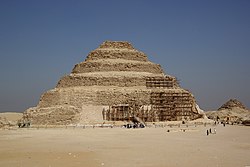Old Kingdom of Egypt
The Old Kingdom is the name for Egypt during the 3rd millennium BC when the civilization of Egypt had its first peak. It was the first of three so-called "Kingdom" periods, which mark the high points of civilization in the lower Nile Valley (the others being Middle Kingdom and the New Kingdom of Egypt).
Old Kingdom was the best by the Third Dynasty through to the Sixth Dynasty (2686 BC – 2134 BC). Many Egyptologists also include the Memphite Seventh and Eighth Dynasties in the Old Kingdom as a continuation of the administration centralized at Memphis. The Old Kingdom was followed by a period of disunity and relative cultural decline that is called the First Intermediate Period by Egyptologists.
The royal capital of Egypt during the Old Kingdom was Memphis. During the Old Kingdom era the great pyramids were built to be burial tombs for the Pharaohs. Because Pharaohs were believed to be given authority from heaven, they wished to walk to Ra, their Sun-god, after death. King Zoser's adviser Inhotep designed the pyramid, hoping to easily reach Ra. The tombs were built on the west bank of the Nile where the sun seemed to set. For this reason, the Old Kingdom is sometimes called "The Age of the Pyramids."
Khufu, called Cheops, was the Pharaoh who built the Great Pyramid at Giza, near Cairo. He believed his soul never died, so they stored food, clothes, and things he owned in the rooms of the pyramid. The Great Pyramid is one of the Seven Wonders of the World: tall as a forty-story building, it took a hundred thousand men twenty years to build. With only ramps and physical energy, they had to move and lift into place 2,300,000 blocks of limestone that were about two and one-half tons apiece. Slaves, farmers, and gangs of men had to work on the Great Pyramid, and were paid with valuable things, not coins (Egyptians had no coins).
To guard the pyramids, a huge stone statue called the Great Sphinx was created and placed nearby. The Great Sphinx has a man's head and a lion's body, with paws 50 ft (15 m) long.
At last, the priests overthrew the Pharaohs. Then the nobles and priests ruled.
Further reading
- Jaromir Malek, In the Shadow of the Pyramids: Egypt During the Old Kingdom, University of Oklahoma Press, 1986. ISBN 0-8061-2027-4
- Egyptian Art in the Age of the older set of Pyramids, New York, Metropolitan Museum of Art, 1999. ISBN 0-87099-906-0 (catalogue for travelling exhibition of the same name)
- The Fall of the Egyptian Old Kingdom
Old Kingdom Of Egypt Media
- Cairo, Gizeh, Sphinx and Pyramid of Khufu, Egypt, Oct 2004.jpg
The Great Sphinx of Giza in front of the Great Pyramid of Giza
- Kairo Museum Statuette Cheops 03 (cropped).jpg
Khufu, the builder of the Great Pyramid at Giza
- False door from the tomb of Metjetji MET DT259192.jpg
False door from the Tomb of Metjetji. ca. 2353–2323 BC, Dynasty 5–6, Old Kingdom. Tomb of Metjetji at Saqqara.
- Extended Data Fig. 2 Facial reconstruction and depiction created from the Nuwayrat individual skull.jpg
Facial reconstruction and depiction created from the Nuwayrat individual skull.
- Ancestry model of Nuwayrat genome (2855-2570 cal. BCE).png
Ancestry model of Egyptian genome from Nuwayrat.
The Pyramid of Djoser at Saqqara.
The Temple of Djoser at Saqqara
Limestone Ka statue of Djoser from his pyramid serdab at Saqqara, Egyptian Museum, Cairo
The head of a King, likely Huni c. 2650–2600 BC, Brooklyn Museum.
Other websites
- Middle East on the Matrix: Egypt, The Old Kingdom Archived 2006-05-16 at the Wayback Machine – Photographs of many of the historic sites dating from the Old Kingdom
- Old Kingdom of Egypt- Aldokkan


